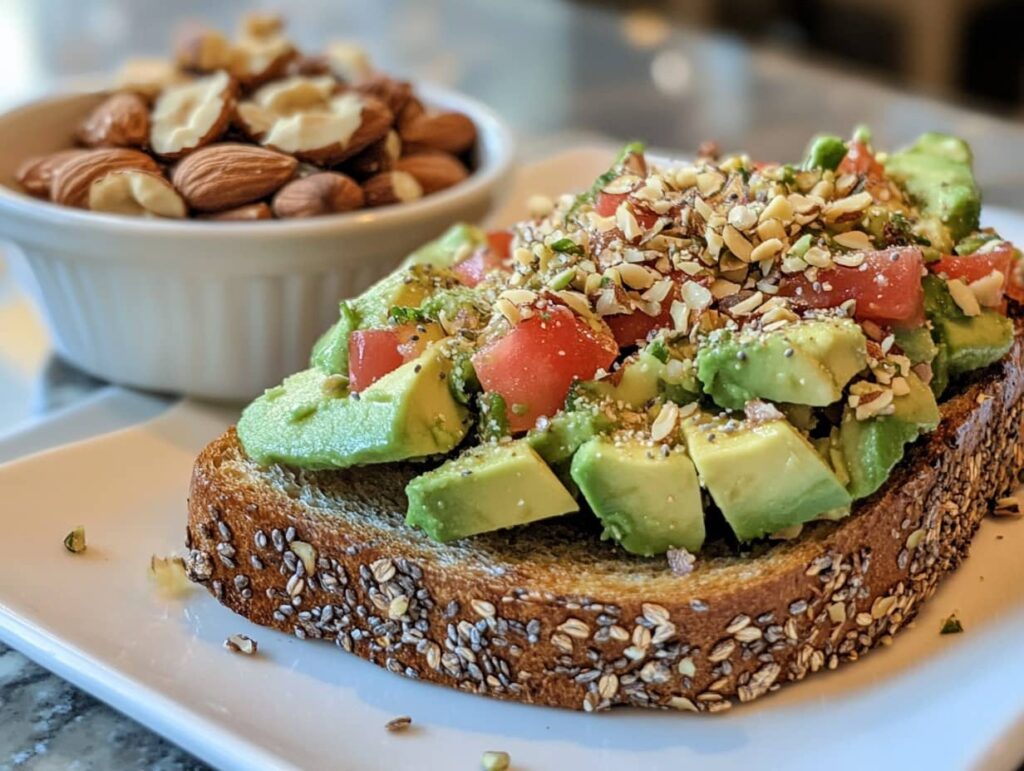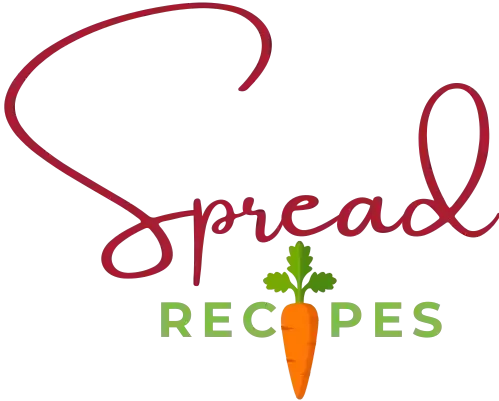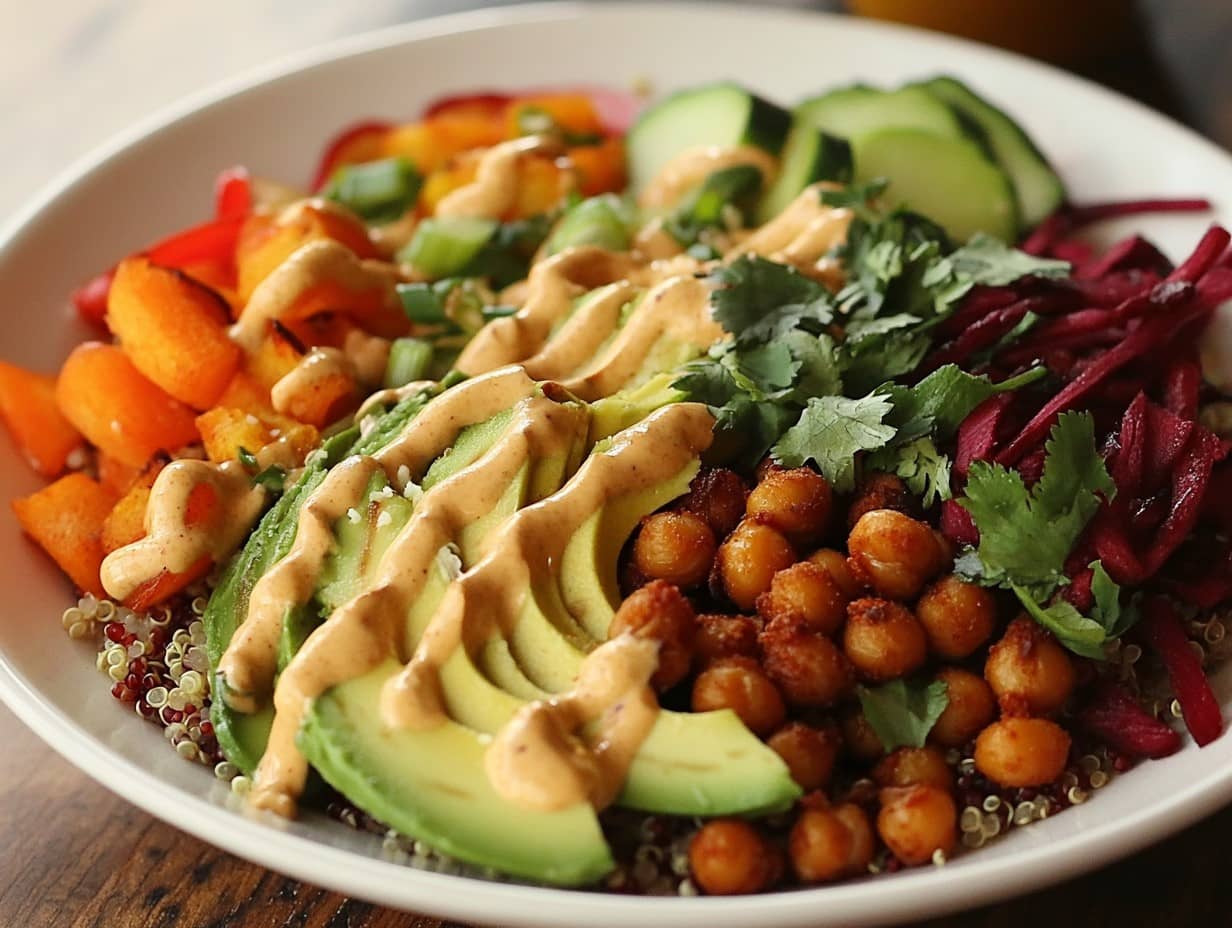The Importance of Satiety in Vegan Diets
Switching to a vegan lifestyle can feel amazing healthier meals, sustainable choices, and a planet-friendly impact. But if you’ve ever asked yourself, “How to make vegan food filling?” or wondered, “Why am I always hungry after eating vegan food?” you’re not alone. Feeling full, or “satiated,” plays a crucial role in staying happy and healthy, regardless of what kind of diet you follow.
Let’s explore why some vegan meals might leave you unsatisfied and uncover practical tips for how to make vegan food filling.
Why Vegan Diets Are Sometimes Less Filling
It’s no secret that plant-based foods are often lower in calories than animal products. A big bowl of salad? Delicious, but not exactly belly-filling without the right add-ons. Many beginner vegans load up on vegetables but skimp on protein, fats, or dense carbs all of which are critical to keeping you full. The result? Hunger strikes soon after, making many wonder how to make vegan food filling.
Beyond calorie content, animal products naturally provide high levels of certain macronutrients like protein and fat, which digest slower and help you feel satisfied longer. Without these, you might be missing an important piece of the puzzle when learning how to make vegan food filling.
How Satiety Impacts Nutrition and Health
Feeling full is about more than just avoiding that “hangry” mood (though that’s important too). Satiety impacts how you manage cravings, maintain a healthy weight, and sustain energy levels throughout the day. Vegan diets, when planned thoughtfully, can meet all your nutritional needs and keep you satisfied. The trick lies in knowing what to include and how to balance your plate.
The Role of Macronutrients in Vegan Satiety
Building a filling vegan meal is all about balance. Think of your plate as a team effort each macronutrient plays a part. Neglect one, and your satisfaction score plummets.
Understanding Protein Needs on a Vegan Diet
Protein is a superstar when it comes to feeling full. It takes longer to digest than carbs and helps regulate hunger hormones. But here’s the catch: if you’re figuring out how to make vegan food filling, you’ll notice that vegan protein sources like beans, lentils, or tofu may have slightly less protein per serving compared to meat. That’s why doubling up on these foods or combining them is key to crafting satisfying meals.
Pro Tip: Pair a grain like quinoa with beans to form a complete protein. Your body will thank you!
Learn more about stocking up on staple vegan foods to ensure you always have protein options on hand.
Healthy Fats: The Secret to Long-Lasting Fullness
Don’t fear fats they’re the MVPs of satiety! If you’re wondering how to make vegan food filling, look no further than a drizzle of olive oil, a handful of nuts, or creamy avocado slices. These not only enhance flavor but also slow digestion, helping your body stay fueled longer.
Fats are essential for more than just satiety they’re crucial for absorbing fat-soluble vitamins. Plus, they trigger a hormone called leptin, which signals your brain that you’re full. Skipping fats? You’re likely skipping satisfaction too. Check out vegan appetizers and tips for ideas on integrating fats into snackable dishes.
The Role of Complex Carbohydrates in Feeling Full
Simple carbs like white bread or sugary snacks might give you a quick energy boost, but they won’t keep you full for long. Enter complex carbohydratesthe heroes of steady energy and lasting satiety. If you’re still asking how to make vegan food filling, these carbs are your answer.
Found in foods like brown rice, oats, and sweet potatoes, complex carbs take longer to digest, fueling your body for hours.
Think of complex carbs as the slow-burning wood on your metabolic fire. They’re what keep you going strong all day!
High-Protein Vegan Foods for Maximum Satiety
Now that you understand the importance of protein, let’s look at some of the best vegan options to pack your meals with staying power.
Legumes: Beans, Lentils, and Chickpeas
Legumes are plant-based powerhouses. They’re loaded with protein, fiber, and a variety of vitamins and minerals. Whether you’re making a hearty lentil stew or tossing chickpeas into a salad, they’re versatile and satisfying.
Nutrition Facts for Lentils (per 1 cup, cooked):
| Nutrient | Amount |
|---|---|
| Calories | 230 |
| Protein | 18g |
| Fiber | 15g |
| Carbs | 40g |
| Iron | 37% DV |
Tofu, Tempeh, and Seitan: Versatile Plant Proteins
Staples in many vegan kitchens, tofu and tempeh offer unique textures and flavors that cater to a variety of dishes. While tofu is soft and incredibly versatile, tempeh stands out with its nuttier taste and firmer texture. If you’re craving something with a chewy, meat-like consistency, seitan made from wheat gluten can be an excellent choice.
Feeling adventurous? Crumble tempeh as a ground meat substitute in tacos!
Nuts and Seeds: Protein-Packed Snacks
Don’t underestimate the power of a handful of almonds or sunflower seeds. They’re small, but they pack a protein punch while offering healthy fats. Spread some almond butter on whole-grain toast or sprinkle chia seeds into your smoothie.
Nutrition Snapshot: Chia Seeds (per 2 tablespoons):
| Nutrient | Amount |
|---|---|
| Calories | 138 |
| Protein | 5g |
| Fiber | 10g |
| Omega-3 | 4.9g |
Incorporating Fiber for Sustained Fullness
Fiber might just be your best friend when it comes to feeling full. Not only does it slow digestion, but it also adds bulk to meals, tricking your stomach into thinking you’ve eaten more than you have.
Whole Grains and Their Nutritional Value
Switching from refined grains to whole grains can make all the difference. Quinoa, farro, and barley are not only more nutritious, but they’re also much more satisfying.
Why eat white rice when you can have the nutty, chewy goodness of brown rice?
Fruits and Vegetables Rich in Soluble Fiber
Certain fruits and vegetables like apples, carrots, and broccoli are rich in soluble fiber, which absorbs water and forms a gel-like substance in your stomach. This keeps you full and helps stabilize blood sugar levels.
Top Picks for High-Fiber Produce:
- Apples (4g per medium apple) 🍎
- Broccoli (5g per cup) 🥦
- Carrots (3.6g per cup) 🥕
Psyllium Husk and Chia Seeds for Fiber Boosts
If you’re looking to take fiber to the next level, try psyllium husk or chia seeds. These superfoods expand in your stomach when mixed with water, creating a feeling of fullness. Just be sure to drink plenty of fluids with them!
Balancing Fats for Filling Vegan Meals
If you’ve ever felt like something’s missing from your vegan meal, chances are it’s healthy fats. These magical macronutrients don’t just add flavor they play a key role in keeping you full and energized. Let’s dive into the tastiest and most effective ways to use fats in your vegan diet.

Avocado: The Creamy Satiety Champion
Avocado isn’t just trendy; it’s a nutritional powerhouse. Packed with heart-healthy monounsaturated fats, fiber, and essential vitamins, it’s no wonder avocado toast is a breakfast favorite. The creamy texture also makes it a great substitute for dairy-based spreads.
Pro Tip: Mash some avocado on whole-grain bread and sprinkle it with hemp seeds for a satisfying snack.
Nutrition Snapshot for Avocado (½ medium):
| Nutrient | Amount |
|---|---|
| Calories | 120 |
| Healthy Fats | 11g |
| Fiber | 5g |
| Vitamin C | 10% DV |
Cooking with Coconut Milk and Olive Oil
Coconut milk isn’t just for curries it’s a creamy, fat-rich addition to soups, smoothies, and even desserts. Olive oil, on the other hand, is a staple in Mediterranean-style cooking, known for its robust flavor and health benefits. These fats not only add richness but also help you absorb fat-soluble vitamins like A, D, E, and K.
Experiment with coconut milk in your oatmeal or drizzle olive oil over roasted veggies for a simple upgrade.
How Omega-3s Contribute to Satiety
Omega-3 fatty acids are the secret weapon for feeling full while also supporting brain health and reducing inflammation. Flaxseeds, walnuts, and algae-based supplements are excellent vegan sources of this essential nutrient.
Why not sprinkle some ground flaxseed over your morning cereal? You’ll feel full and fuel your brain for the day.
For more inspiration, learn how to design the perfect vegan menu for every occasion.
Meal Composition Strategies for Vegan Fullness
Now that you know what to eat, let’s talk about how to combine these powerhouse ingredients for meals that satisfy your hunger and your taste buds.
The Power of Combining Macronutrients
A filling vegan meal is like a well-rehearsed symphony each macronutrient plays its part in perfect harmony. Combining proteins, healthy fats, and complex carbs ensures your body gets what it needs to feel full and stay energized.
Here’s an easy formula for a balanced meal:
- Protein: Tofu, beans, or lentils.
- Healthy Fats: Avocado, nuts, or a drizzle of olive oil.
- Carbs: Whole grains like quinoa or sweet potatoes.
Portion Sizes: Not Too Little, Not Too Much
While it’s tempting to pile your plate high, oversized portions can backfire, leaving you sluggish rather than satisfied. Aim for mindful portion sizes that balance variety and density.
Visualize your plate: half filled with veggies, a quarter with protein, and the last quarter with whole grains.
Timing Your Meals for Maximum Satisfaction
Spacing out meals throughout the day can help prevent blood sugar dips and the dreaded “afternoon hangry attack.” Consider adding small, balanced snacks between meals to maintain energy.
Feeling peckish? Try apple slices with almond butter. It’s the perfect blend of fiber, healthy fats, and natural sweetness.
Common Challenges in Making Vegan Food Filling
No diet is perfect, and veganism comes with its own set of challenges when it comes to feeling satisfied. The good news? There’s always a solution.
Avoiding Over-Reliance on Low-Calorie Foods
Salads are great, but if they’re your mainstay, they might leave you hungry. While greens are nutrient-dense, they’re low in calories. To make a salad more filling, add quinoa, roasted chickpeas, or a creamy tahini dressing.
Breaking the Myth of “Rabbit Food” in Veganism
The stereotype of vegans surviving on carrot sticks and lettuce is outdated and wrong. Vegan meals can be hearty, rich, and indulgent if you use the right ingredients and techniques. Think savory stews, cheesy cashew dips, or even decadent plant-based burgers. For example, explore spicy potato flatbread recipes for a unique twist on comfort food.
Vegan food isn’t boring; it’s a canvas waiting for bold flavors and creative twists!
Managing Hunger on a Budget-Friendly Vegan Diet
Eating well on a budget can be tough, but it’s entirely doable with planning. Bulk staples like lentils, beans, and rice are affordable, versatile, and incredibly filling. For inspiration, check out these vegan snack ideas.
Budget-Friendly Shopping Tips:
- Buy dry goods like grains and legumes in bulk.
- Stock up on frozen fruits and vegetables.
- Skip pre-packaged vegan snacks; make your own instead!
Easy and Filling Vegan Recipes to Try
Let’s put everything into action with some simple, delicious recipes that showcase the principles of satiety.
Hearty Vegan Chili with Lentils and Sweet Potatoes
Ingredients:
| Ingredient | Quantity |
|---|---|
| Lentils (dry) | 1 cup |
| Sweet potatoes (diced) | 2 medium |
| Onion (chopped) | 1 medium |
| Garlic (minced) | 3 cloves |
| Crushed tomatoes | 1 can (14 oz) |
| Vegetable broth | 3 cups |
| Spices (cumin, chili) | 2 tsp each |
Instructions: Sauté onion and garlic, add spices, then toss in lentils, sweet potatoes, tomatoes, and broth. Simmer for 30 minutes.
Protein-Packed Smoothies with Spinach and Pea Protein
This smoothie is a quick, on-the-go option that fills you up without weighing you down.
Ingredients:
- 1 scoop pea protein powder
- 1 cup unsweetened almond milk
- 1 handful spinach
- 1 frozen banana
- 1 tablespoon peanut butter
Blend until smooth, and enjoy!
Whole-Grain Buddha Bowls with Tahini Dressing
Combine roasted veggies, quinoa, and chickpeas in a bowl, then drizzle with tahini and lemon juice for a filling meal. You can explore more balanced vegan meal ideas in the vegan snack guide.
Expert Tips for Making Vegan Food More Satisfying
Crafting a filling vegan meal is both an art and a science. From preparation techniques to flavor boosts, there are countless ways to enhance satiety and make your meals truly satisfying. Let’s explore some practical and creative tips.
Meal Prepping for Consistent Satiety
Preparing meals in advance ensures you always have satisfying options. Stock your kitchen with ingredients from staple vegan foods to save time and maintain variety.
How to Start Meal Prepping:
- Cook large batches of quinoa, lentils, or brown rice.
- Wash and chop fresh vegetables for easy access.
- Prepare sauces like tahini or cashew cream to elevate your dishes.
Pro Tip: Invest in airtight containers to keep your prepped ingredients fresh all week.
Stock your kitchen with ingredients from staple vegan foods to save time and maintain variety.
Exploring Global Cuisines for Filling Vegan Dishes
Different cultures offer endless inspiration for hearty, plant-based meals. Take a cue from cuisines that naturally emphasize legumes, grains, and bold flavors.
Examples:
- Indian: Lentil-based curries like dal, paired with roti or rice.
- Mediterranean: Falafel with hummus, tabbouleh, and pita bread.
- Mexican: Bean burritos or enchiladas smothered in a zesty tomato sauce.
Enhancing Flavors with Spices for Appetite Satisfaction
A flavorful meal feels more satisfying, and spices are your best friend. Beyond taste, spices like cayenne, turmeric, and cinnamon may also help regulate appetite and metabolism.
Feeling uninspired? Try sprinkling smoked paprika or nutritional yeast on roasted veggies for a flavor explosion!
The Future of Vegan Satiety Innovations
As the popularity of veganism grows, so do the advancements in making plant-based meals more satisfying. Let’s take a peek at what the future holds.
Plant-Based Meat Alternatives: A Satiety Game Changer?
Products like Beyond Meat and Impossible Foods are revolutionizing vegan diets. These alternatives closely mimic the texture and protein content of meat, offering a convenient way to feel full.
While they’re great for the occasional treat, don’t forget to balance them with whole foods for maximum nutrition.
Research on Satiety-Enhancing Plant Ingredients
Scientists are continuously exploring plant-based compounds that can naturally boost satiety. From pea protein isolates to algae-derived omega-3s, the possibilities are exciting. These innovations aim to make vegan diets not just filling but also nutritionally optimized.
Personalized Nutrition for Long-Lasting Vegan Meals
Thanks to advances in technology, personalized meal plans based on your specific needs are becoming more accessible. Apps and services can analyze your dietary requirements and suggest meals that keep you satisfied all day.
Imagine a future where your meal plan adjusts to your hunger levels and energy needs in real time. Pretty cool, right?
FAQs
What are the best vegan proteins for satiety?
Legumes like lentils, chickpeas, and black beans are excellent sources of protein. Tofu, tempeh, and seitan also pack a punch.
Can vegan meals provide enough calories to stay full?
Absolutely! Focus on calorie-dense foods like avocados, nuts, seeds, and whole grains to ensure your meals are filling and energy-packed.
How can I make my salads more filling?
Add protein sources like chickpeas or tofu, healthy fats like avocado, and a hearty grain like quinoa. Don’t forget a flavorful dressing!
Do plant-based meats help with satiety?
Yes, plant-based meats are high in protein and can mimic the texture of traditional meat, making them a satisfying option.
What’s the role of fiber in feeling full?
Fiber slows digestion and adds bulk to meals, helping you feel full longer. Foods like whole grains, fruits, and vegetables are great sources.
How can I meal prep for a filling vegan diet?
Prepare staples like grains, legumes, and roasted veggies in advance. Store them in containers and mix and match for quick, balanced meals.
Conclusion: Crafting Filling and Nutritious Vegan Meals
Making vegan food filling is about balance, creativity, and knowing your ingredients. By combining protein, fiber, and healthy fats while experimenting with global flavors, you can create meals that are as satisfying as they are delicious. Whether you’re new to veganism or a seasoned pro, the key is to approach your meals with intention and excitement. For more ideas on enhancing your vegan diet, explore our curated list of vegan appetizers and recipes. With the right strategies, you’ll never feel like your meals are missing something again.
Remember: A full stomach and a happy heart go hand in hand. With these tips, you’ll never feel like something’s missing again. 🌱

